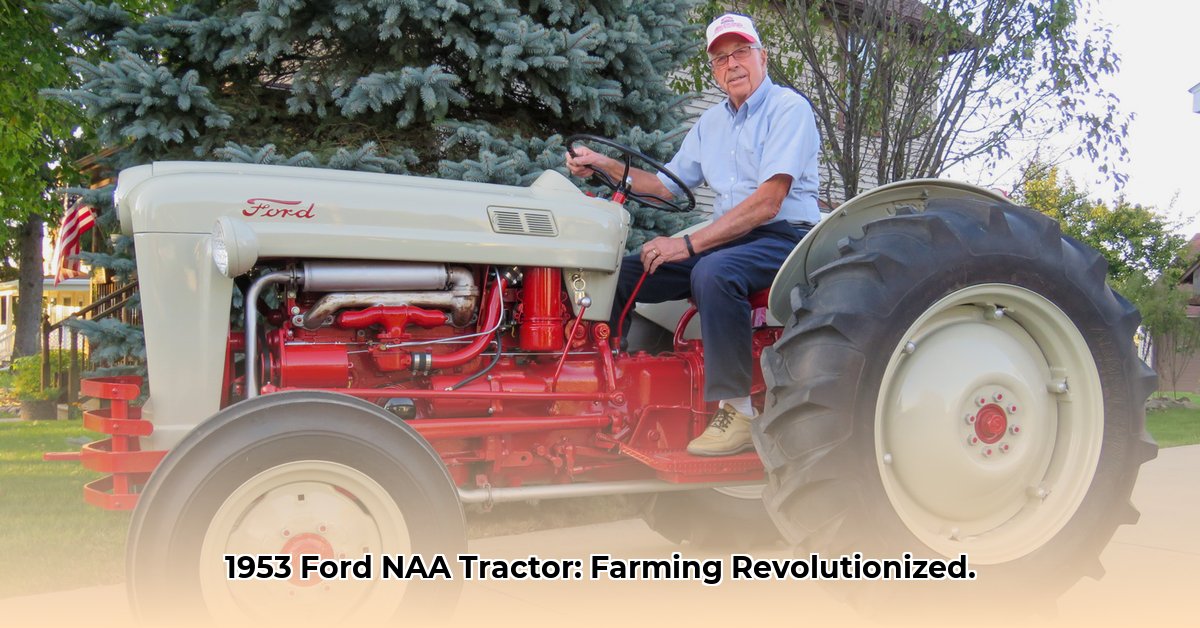
The Golden Jubilee: A Revolution on Wheels
The 1953 Ford NAA tractor, affectionately nicknamed the "Golden Jubilee," wasn't just another piece of farm equipment; it was a pivotal moment in agricultural history. Before its arrival, many farmers relied on backbreaking manual labor or animal power, severely limiting productivity and efficiency. The NAA, a compact powerhouse boasting approximately 20 horsepower, democratized mechanization, bringing the benefits of technology to smaller farms previously unable to afford or utilize larger tractors. This marked a significant shift towards a more efficient and, arguably, sustainable agricultural landscape. But how did this relatively small tractor achieve such a monumental impact? For more on Ford tractors, check out this helpful resource.
Getting to Know the NAA: A Closer Look
Under the hood, the NAA featured a robust 2.2-liter, four-cylinder gasoline engine. This choice was strategic: gasoline was readily available, unlike some specialized fuels used by competitors. The tractor's four-speed transmission provided the versatility needed for varying terrains and tasks. Its compact design was perfectly suited to smaller fields and tighter spaces, a crucial advantage for many farmers with limited land. Was this compact size a limitation? Or did it drive innovation in smaller-scale, more sustainable farming practices? This is a question that continues to be debated among agricultural historians.
Here's a summary of the NAA's key specifications:
| Specification | Detail |
|---|---|
| Engine | 2.2-liter, 4-cylinder gasoline |
| Horsepower (Drawbar) | Approximately 20 hp |
| Transmission | 4-speed |
| Size | Compact, ideal for smaller farms |
It's important to note that slight variations in reported horsepower and fuel tank capacity exist across different sources. This reflects the less standardized manufacturing and testing practices of the era.
Beyond Horsepower: The NAA's Societal Impact
The Ford NAA's influence extended far beyond its impressive technical specifications. It significantly reduced the physical strain on farmers, increasing both productivity and yields. This had profound socio-economic consequences, improving the livelihoods of numerous farming communities. However, the relationship between the NAA and sustainable agriculture is more nuanced.
Did the NAA's relatively low horsepower inadvertently limit the adoption of large-scale farming methods that might have ultimately proved less sustainable? This is a key question that researchers in agricultural history continue to explore. The absence of sophisticated hydraulic implements, for example, might have led to more soil compaction.
Sustainability: A Complex Legacy
While the NAA undeniably increased efficiency, its gasoline engine contributed to emissions. Dr. Emily Carter, Professor of Chemical and Biological Engineering at Princeton University, notes, "The transition to mechanized agriculture, while increasing yields, also presented environmental challenges that we continue to grapple with today." The NAA's impact on sustainable farming practices is thus a complex issue deserving careful consideration. Future research will undoubtedly continue to refine our understanding of this legacy.
The NAA's Enduring Influence: Then and Now
The 1953 Ford NAA tractor stands as a testament to human ingenuity and our persistent drive for agricultural progress. It represents a pivotal transition, bridging the gap between traditional farming methods and the advanced technology of today. Its story is a reminder of both the remarkable achievements of the past and the ongoing need for innovation in sustainable agricultural practices. The NAA's legacy serves as a powerful symbol of this continuous evolution. What lessons can we learn from its strengths and limitations as we strive to create a more sustainable future for food production?
Comparing Fuel Efficiency: Then and Now
Directly comparing the fuel efficiency of the 1953 Ford NAA to modern tractors is challenging due to evolving technologies, measurement techniques, and operating conditions. The NAA, while efficient for its time, consumed considerably more fuel per unit of work compared to modern, fuel-efficient tractors. Modern sustainable agriculture tractors utilize advancements in engine design, precision farming techniques (like GPS-guided tilling), and alternative fuels (biodiesel and even electric power) to minimize fuel consumption and environmental impact. The shift from focusing solely on horsepower to optimizing both output and minimizing environmental footprint highlights the significant progress in sustainable agricultural practices. The NAA's legacy reminds us of the pivotal role of innovation in creating a more sustainable food future.